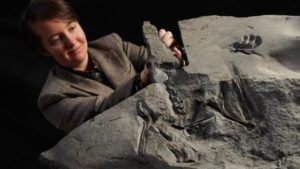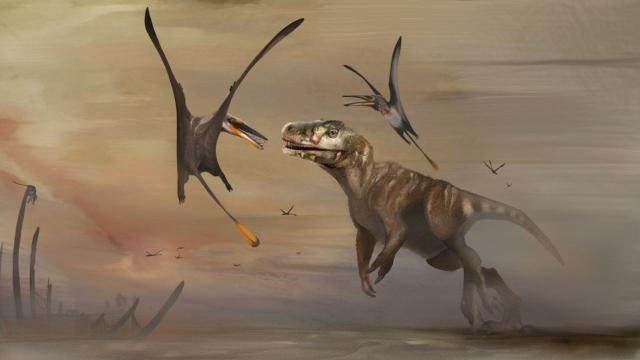A giant pterosaur fossil has been uncovered in Scotland, found on the Isle of Skye. It’s in incredible condition and the largest fossil of its kind from the Jurassic Period.
The pterosaur was a giant winged cousin of the dinosaur, with a wingspan of more than 2.5 metres, living some 170 million years ago. It has been preserved better than any other pterosaur skeleton found in Scotland, according to experts. Also, yes, pterosaurs and dinosaurs are different things and were the first vertebrates to evolve powered flight, about 50 million years before birds.
Analysis of the fossil, given the name Dearc Sgiathanach (pronounced jark ski-an-ach), indicated that the pterosaur had large optic lobes, which could mean that the pterosaur had good eyesight.
“Even in the context of the amazing palaeontological finds on Skye in recent years, this one really is remarkable,” says Doctor Nick Fraser from National Museums Scotland.
“To find and describe a specimen which is both so well-preserved and so significant is really special and we’re delighted to add Dearc into our collection, a unique addition to the fossil record and a specimen which will be studied now and long into the future.”
The skeleton was originally found back in 2017, during a National Geographic Society-funded excavation. Discovered by University of Edinburgh PhD student Amelia Penny, the skeleton’s jaw was spotted protruding from a limestone layer on a tidal platform.

“Dearc is a fantastic example of why palaeontology will never cease to be astounding,” added Natalia Jagielska from the School of GeoSciences.
“Pterosaurs preserved in such quality are exceedingly rare and are usually reserved to select rock formations in Brazil and China. And yet, an enormous superbly preserved pterosaur emerged from a tidal platform in Scotland.
“To achieve flight, pterosaurs had hollow bones with thin bone walls, making their remains incredibly fragile and unfit to preserve for millions of years. And yet our skeleton, ~160 million years on since its death, remains in almost pristine condition, articulated and almost complete.”
It’s always terrific news when we come across a well-preserved fossil from the ancient world (not in a Jurassic World kind of way, but in more of a ‘Here’s how the natural world came to be’ kind of way). Some months ago, a beautifully preserved dinosaur embryo was found inside of a fossilised egg.
Although pterosaurs were previously considered to be much smaller during the Jurassic Period (with some fossils hinting to bigger Jurassic era pterosaurs), this fossil confirms that there were larger pterosaurs at the time.
The Dearc fossil will be added to the fossil collection at National Museums Scotland and the find has been published in the scientific paper Current Biology.
